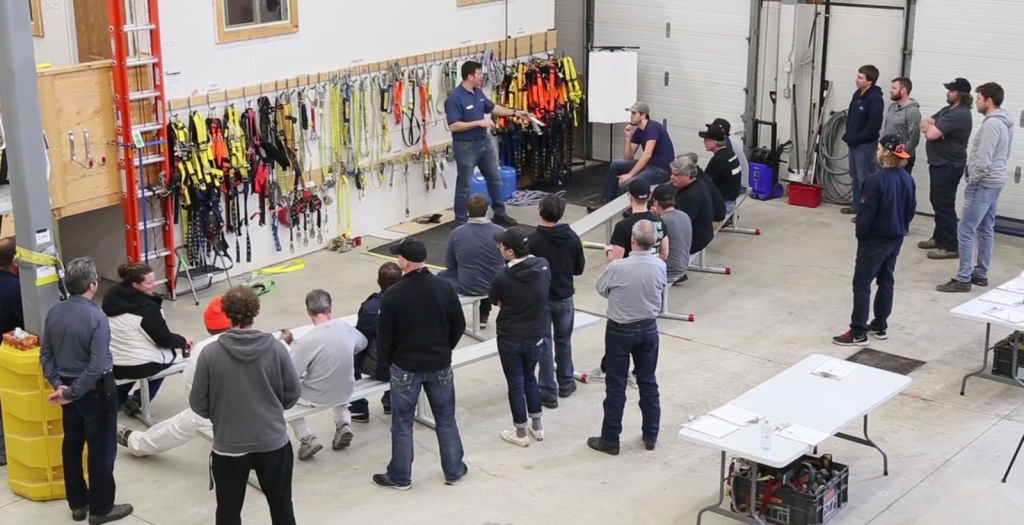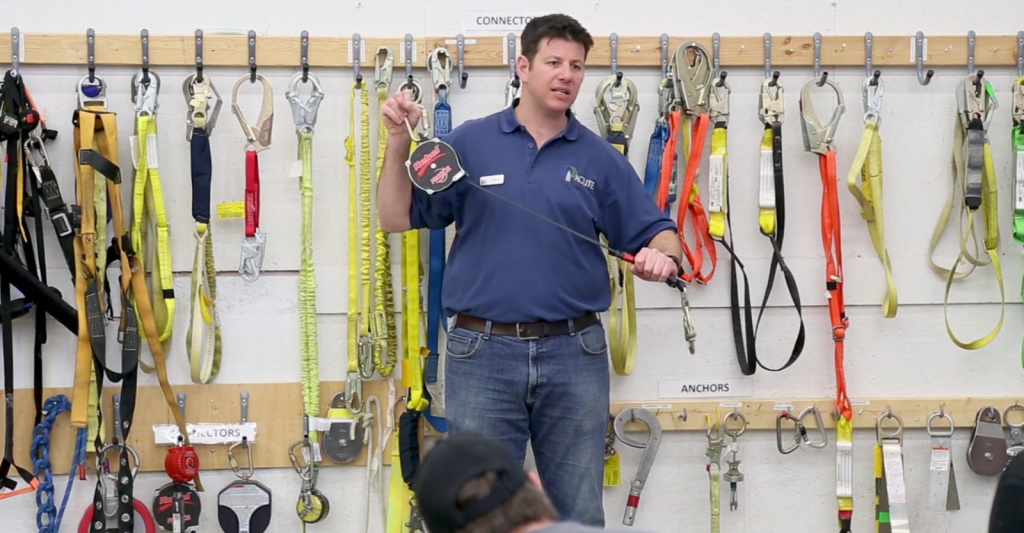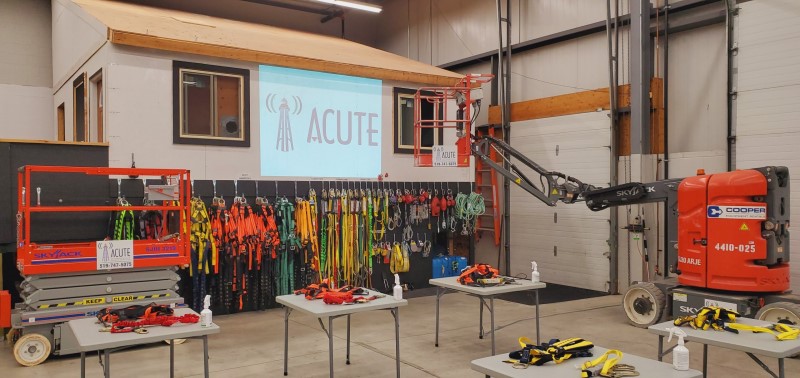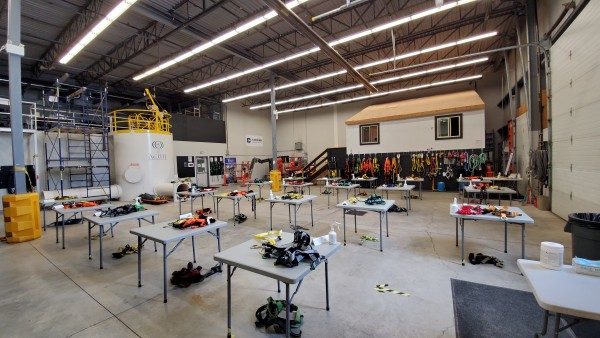If you work in construction or any job that involves fall protection equipment, Working at Heights (WAH) training isn’t optional — it’s the law. Ontario’s Ministry of Labour, Immigration, Training and Skills Development (MLITSD) sets strict safety standards to prevent workplace injuries and fatalities related to falls.
Before stepping onto a site, every worker using fall protection must complete an approved Working at Heights training program delivered by an approved provider. Employers are responsible for verifying and maintaining training records, and refresher courses are required every three years to stay compliant.
Below, we’ll break down the key Ontario laws and regulations you need to know about Working at Heights training — including certification requirements, employer responsibilities, course components, and renewal timelines.
- Law #1: Ontario requires that anyone working on a construction project who uses fall protection equipment must take working at heights training.
- Law #2: Your employer is responsible for getting a record of training from your working at heights training provider.
- Law #3: A thorough working at heights training program will include both a theory component and a practical component.
- Law #4 Working at heights training is good for 3 years from the date you complete an approved training program delivered by an approved training provider.
You can trust ACUTE for the best safety training possible, including working at heights training. ACUTE’s experienced team members have been serving safety professionals for over 20 years. Contact us today to sign up.
Ontario Working at Heights Training Laws

Law #1: Ontario Requires Working at Heights Training for Anyone Using Fall Protection
Yes. Ontario requires that anyone working on a construction project who uses fall protection equipment must take working at heights training. Here is the criteria for your training as set out by the Ontario government:
- Your training must be approved by the Ministry of Labour, Immigration, Training and Skills Development’s Chief Prevention Officer
- Your training needs to be delivered by a training provider who has been approved by the Chief Prevention Officer
- Your training needs to be completed before you can use fall protection
Working at heights training requirements are set out in O. Reg. 297/13: Occupational Health and Safety Awareness Training.
Specific Requirements for Working at Heights Training in Ontario
According to O. Reg. 213/91: Construction Projects, you will need to take working at heights training if you work on a construction project that is covered by O. Reg. 213/91 and you need to use any of the following fall protection methods:
- Travel restraint system
- Fall restricting system
- Fall arrest system
- Safety net
- Work belt
- Safety belt
There are, however, limited exemptions if you are a worker who is directly employed by an automobile manufacturer or assembler.
Law #2: Employers Must Keep a Record of Working at Heights Training

Yes. According to O. Reg. 213/91: Construction Projects. Your employer is responsible for getting a record of training from your working at heights training provider. This record must:
- Be a written training and instruction record
- Be signed by the training provider
- Include the worker’s name and the dates that the training was taken
- It will be made available if an inspector requests to see it
Law #3: Working at Heights Training Must Include Theory and Practical Components
A thorough working at heights training program will include both a theory component and a practical component. For example, if you take your training at ACUTE, you will learn the following:
Working at Heights Theory
The theory component of ACUTE’s Working at Heights training takes approximately three hours and provides a strong foundation in Ontario’s legal requirements and safe practices for preventing falls.
This in-class session is led by experienced, Chief Prevention Officer (CPO)–approved instructors and follows the Ministry of Labour, Immigration, Training and Skills Development (MLITSD) Working at Heights Training Program Standard.
Topics Covered:
-
Overview of the Occupational Health and Safety Act (OHSA) and Working at Heights (WAH) legislation
-
Common workplace fall hazards and how to recognize them
-
Safe work plans, hazard assessment, and control measures
-
Applying the hierarchy of controls to fall prevention
-
Fall prevention and fall protection strategies
-
Types and proper use of fall arrest systems
-
Ladder safety, setup, and inspection
At the end of this module, you’ll complete a written evaluation to ensure full comprehension of all safety principles discussed.
Working at Heights Practical Component (Approx. 3.5 Hours)
The practical session allows participants to apply what they’ve learned in a controlled, hands-on environment. This portion focuses on safely using, inspecting, and maintaining fall-protection systems and equipment.
Topics Covered:
-
Requirements and limitations of fall-prevention and fall-protection systems
-
A-B-C components (anchorage, body support, connecting devices): selection, inspection, and use
-
Harness fitting, lanyard inspection, and evaluation
-
Travel restraint and fall arrest system setup
-
Maintaining 100% tie-off while working at heights
-
Safe use of ladders, scaffolds, and elevating work platforms (EWPs)
Note: Under Ontario’s Construction Projects Regulation, workers on EWPs must remain attached to an adequate anchorage point while the platform is in motion.
-
Rescue plans — components, purpose, and implementation
-
Identifying and using safe anchor points
Participants complete both a written and a practical evaluation to demonstrate competence and earn their certificate of completion.
Learning Methods & Program Delivery
ACUTE’s Working at Heights training program uses interactive and varied learning techniques to ensure knowledge retention and confidence on the job:
-
Instructor-led classroom discussion with real-world examples
-
Tabletop safety scenarios and collaborative exercises
-
Hands-on demonstrations using certified fall-protection equipment
-
Detailed handouts, videos, and quizzes
-
One-on-one coaching and performance evaluations
Training begins at 8:30 a.m. and runs as a full-day course. Because class size, discussion, and participant experience may affect pacing, timing can vary slightly.
Participants must attend the entire course to receive certification.
Prerequisites: None. However, ACUTE recommends completing Basic Occupational Health and Safety Awareness Training (O. Reg. 297/13) before attending Working at Heights training.
🕒 Sample Working at Heights Training Schedule
|
|||||||||||||||||||||||||
|---|---|---|---|---|---|---|---|---|---|---|---|---|---|---|---|---|---|---|---|---|---|---|---|---|---|
ACUTE’s Training Facility

You can choose to either take your Working at Heights training at our world-class facility, or if you prefer, we can come to your site. Our training facility features:
- Industry standard health and safety equipment and technologies
- Simulation areas for a full suite of training programs (i.e. working at heights, confined space, and hazardous materials)
- Classroom facilities for lecture and technical training delivery
- Human dummies for confined space rescue and hazardous material controls
Upon successful completion, your Working at Heights certification is valid for three years from the training date. To remain compliant with Ontario law, workers must complete an approved refresher course before the expiry date. Refresher training reinforces safe practices and updates workers on any changes to legislation or equipment standards.
Law #4: Working at Heights Training Is Valid for 3 Years
Working at heights training is good for 3 years from the date you complete an approved training program delivered by an approved training provider. A Working At Heights Refresher course must be taken every 3 years in order for you to remain compliant.
You can trust ACUTE for the best safety training possible, including working at heights training. ACUTE’s experienced team members have been serving safety professionals for over 20 years. You can rely on ACUTE for hands-on, physically distanced, practical safety training to keep your employees safe in the workplace. ACUTE is dedicated to workplace safety and understands the importance of course and training provider approval. Why get workplace safety training with ACUTE? Here are just some of the benefits of working with ACUTE:

- Open Door Instructor-Student Partnership – ACUTE’s training services emphasize client participation. Staff foster relationships with clients and serve as a touchstone for advice anytime moving forward.
- Serving Your Team and Industry – With a vast array of clients in the manufacturing, construction, health, academic, and government sectors, ACUTE brings the best safety practices from across the spectrum to your workplace.
- 100 Years Combined Experience – ACUTE provides comprehensive health and safety training, on-site safety services, and consulting services. With over 100 years of combined experience, our company staff offer more than theoretical or abstract ideas. ACUTE offers solutions.
- Track Record of Success – ACUTE is rated 4.9/5 stars on Google reviews, demonstrating a commitment to our clients, quality, and passion for training.
Check out our course calendar for times and dates of our courses.
What Our Customers Are Saying…
“I work at the University of Guelph as an arborist. Ron Campbell provided a small socially distanced group and myself with working at heights training. Ron has a wealth of knowledge and kept everyone engaged with many “real life” examples of working at heights scenarios and facts. We have also received elevated work platform training with Patrick from Acute training. Patrick is also a very friendly, knowledgeable and engaging professional trainer. I truly believe that the best trainers are those with practical experience and the trainers at Acute have that locked down.”

